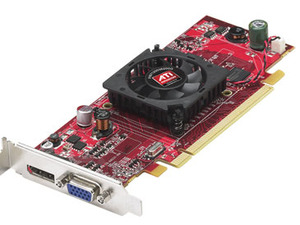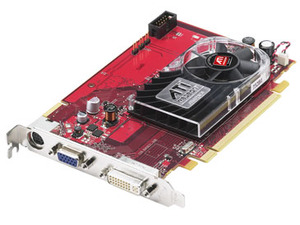
Radeon HD 3400 series
RV620 is AMD’s value-orientated ASIC and is used for both the Radeon HD 3450 and Radeon HD 3470 graphics cards. The Radeon HD 3400 series offer the same set of feature improvements over the Radeon HD 2400 series as the Radeon HD 3650 does over the HD 2600 series.The underlying architecture remains the same, which means there are eight five-way superscalar shader units (or 40 stream processors, depending on which way you take your medicine), four texture units and four raster operators backing out onto a 64-bit memory bus width.
The ASIC supports the same features as the Radeon HD 3650, which includes DirectX 10.1, PCI-Express 2.0, and of course ATI PowerPlay – double precision support is again not confirmed, but I'm waiting to hear back from AMD on that point (Update: now confirmed as per previous page -- Ed.). However, unlike the RV635 though, the RV620 GPU didn't go on a diet – it actually has around a million more transistors than the Radeon HD 2400's 180 million transistors.
Also, there are two distinct products available in the Radeon HD 3400 series: the HD 3450 and the HD 3470 – these will hit price points of around £25-30 (inc. VAT) and £40 (inc. VAT) respectively.
There are clock speed differences, but given the relative performance available, I can’t see that making too much of a difference in games personally – you’re talking about pretty low gaming performance to start with anyway. Indeed, AMD PowerPointed the Radeon HD 3400 series cards as great for video playback, but the company’s representatives didn’t really go into much detail (read: pretty much no detail) on how it performed in games.
That’s not to say you can’t enjoy games on these cards though and, with the help of AMD’s Hybrid CrossFire technology, you can enjoy pretty new games like Call of Duty 4 and Crysis at respectable settings and resolutions. We’ll talk about that in a little while though, as we’re getting ahead of ourselves here.
The Radeon HD 3450 comes clocked at 600MHz core and 1,000MHz memory (effective), while the HD 3470 comes clocked at 800MHz core and 1,900MHz memory (effective). The cards both feature 256MB frame buffers, but the 3450 uses DDR2, while the faster 3470 higher speed DDR3.
Where the clock speed is going to make a difference is in the home theatre space, because AMD has made some improvements to the Unified Video Decoder inside the RV635 and RV620 GPUs. The Radeon HD 3470 and Radeon HD 3650 cards can now decode video at resolutions up to 1440p while, according to AMD, the Radeon HD 3450 doesn’t have quite enough power to deliver smooth video playback at 1440p. However, since this support is pretty much a moot point at the moment as there are no movies (or TVs) that have higher than 1080p resolutions, the fact it can play HD movies back smoothly at 1080p is more than sufficient.
The other thing that is going to make a real difference is the fact that the Radeon HD 3470 is a full-height PCB, while the HD 3450 is just half-height. It’s clear that the HD 3450 is targeted more at the home theatre PC user and AMD says that many of the Radeon HD 3450 cards will be passively cooled, even though it has decided to kit its reference design out with a small active fan.
It's nice that AMD is pushing some decent HD video features on the HD 3470, but it’s surprising to see that the card is full-height – we hope that one of AMD’s partners will make a half-height version of the 3470 because then you get all of the HD video capabilities in the same form factor as the 3450. What would make the deal incredibly sweet would be for that half-height card to be passively cooled. I’m speculating, I know...but if you don’t ask, you don’t get, right?

MSI MPG Velox 100R Chassis Review
October 14 2021 | 15:04














Want to comment? Please log in.